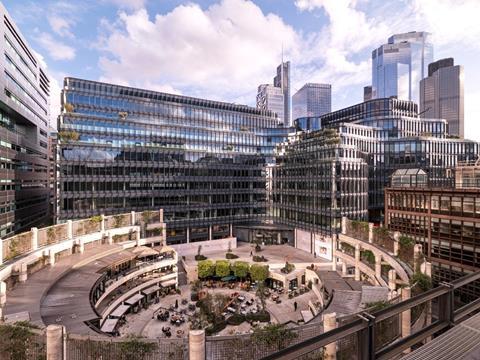Some years ago this building would have been demolished and a new one put in its place, now British Land’s first instinct is to reuse existing structures, says Charles Horne

Embodied carbon covers all the emissions generated to produce a building. It makes up a huge proportion of a building’s whole life carbon. Broadgate is British Land’s 32-acre campus in central London, and because of its scale we are aware of our responsibility to reduce emissions.
Embodied carbon at 100 Liverpool Street, completed in 2020, works out at 389kg per m2. Industry benchmarks available for 2020 average at 1,000kg per m2 *. So, 100 Liverpool Street is way ahead of current market standards. It also exceeds our ambitious target to halve embodied carbon to below 500kg per m2 by 2030 – supporting global efforts to keep warming below 1.5°C.
Some of this is due to fortunate opportunities – it won’t be possible to achieve this on every project in the coming years – but there are also lessons that we’re applying on other developments and sharing to raise industry performance. Here is what we have learned.
The quality of data on the existing building was also key. To make good decisions, you need good information
The biggest impact on embodied carbon at 100 Liverpool Street came from retaining 50% of the existing structure. Here, sustainability went hand in hand with the commercial case. Looking at the four project fundamentals – cost, programme, value and risk – retaining the structure benefited all these, while dramatically cutting embodied carbon.
- Cost: It was slightly cheaper to retain some of the structure rather than demolishing it.
- Programme: This saved some time versus demolishing and rebuilding; probably not as much as you might think, because retaining existing structure requires time for checking, repairing and connecting to the new building. But it did save weeks.
- Value: Fortunately, the existing building was high quality. The structural grid is large – 7.5m and above – ideal for a Grade A product because occupiers want clear sightlines. The structural heights are also good, which again occupiers like for the feeling of airy space. So, from a value perspective, a quality product.
- Risk: With Network Rail premises underneath 100 Liverpool Street, retaining existing foundations rather than building new reduced some exposure and risk. It also cost less and took slightly less time, which lowers risk overall. However, reusing existing structures also carries its own risks. So, we did thorough testing to be sure everything complies with the latest structural strength and stability codes
The quality of data on the existing building was also key. To make good decisions, you need good information. This is influencing our approach to circular economy, and how we’re now designing and recording our structures to be demountable in years to come. That’s essential across the industry.


Offsetting
100 Liverpool Street is also the first building completed as part of our net zero development commitment from 2020. After driving the embodied carbon as low as possible, we offset through nature-based solutions, compensating any carbon we emit. We only invest in certified offset projects that we know have long term viability. We have a portfolio-wide procurement plan with Natural Capital Partners and we’re transparent around how and where we’re offsetting.
The joint venture partners for 100 Liverpool Street – British Land and GIC – have agreed to pay an internal price of £60 per tonne for any outstanding embodied carbon. Around £20 of that goes towards certified offsets and £40 towards the to finance retrofitting of the standing portfolio.
For the whole industry to move forward, we need to be as transparent as possible and share best practice. We must come together on consistent measurement and methodologies and report accurate data. This applies to everything – across the market and up and down the supply chain. Good information makes for good decisions – from the as-built information on existing buildings, to benchmarking ourselves and sharing project insights so we all know how we can do better.
Any self-respecting CEO taking new space now wants it to be zero carbon. It’s night and day different to a few years ago. As a construction professional, if you’d asked me five years ago, “Do you want to leave that structure there or take it down?”, I would always have said, “Take it down,” because to build from new is easy; to build with existing is more complicated. Today, cutting carbon is one of the highest items on the agenda for British Land projects, along with profitability. So, our approach is reuse first, wherever possible.
Charles Horne is project director at British Land and honorary visiting professor at University of East London
* 100 Liverpool Street embodied carbon quantified using the RICS framework for whole life carbon. Independently verified results show an embodied carbon intensity of 389kg CO2e per m2 GIA for A1-5.


























No comments yet